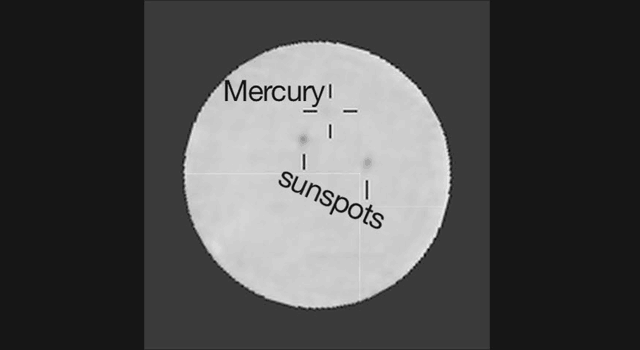English: Mercury Passes in Front of the Sun, as Seen From Mars
http://www.jpl.nasa.gov/news/news.php?release=2014-183
http://www.jpl.nasa.gov/spaceimages/details.php?id=PIA18389
http://www.jpl.nasa.gov/video/?id=1309 => Video
This animated blink comparison shows five different versions of observations that NASA's Curiosity made about one hour apart while Mercury was passing in front of the sun on June 3, 2014. This animated blink comparison shows five versions of observations that NASA's Curiosity made about one hour apart while Mercury was passing in front of the sun on June 3, 2014. Two sunspots, each about the diameter of Earth, also appear, moving much less than Mercury during the hour.
June 10, 2014
NASA's Curiosity Mars rover has imaged the planet Mercury passing in front of the sun, visible as a faint darkening that moves across the face of the sun.
This is the first transit of the sun by a planet observed from any planet other than Earth, and also the first imaging of Mercury from Mars. Mercury fills only about one-sixth of one pixel as seen from such great distance, so the darkening does not have a distinct shape, but its position follows Mercury's expected path based on orbital calculations.
The observation by the telephoto camera of Curiosity's two-eyed Mast Camera instrument is available online at:
http://www.jpl.nasa.gov/video/?id=1309
"This is a nod to the relevance of planetary transits to the history of astronomy on Earth," said Mark Lemmon of Texas A&M University, College Station, a member of the Mastcan science team. "Observations of Venus transits were used to measure the size of the solar system, and Mercury transits were used to measure the size of the sun."
The observations were made on June 3, 2014, from Curiosity's position inside Gale Crater on Mars. In addition to showing the Mercury transit, the same Mastcam frames show two sunspots approximately the size of Earth. The sunspots move only at the pace of the sun's rotation, much slower than the movement of Mercury.
Many viewers on Earth observed a Venus transit in June 2012, the last visible from Earth this century. The next Mercury transit visible from Earth will be May 9, 2016. Mercury and Venus transits are visible more often from Mars than from Earth, and Mars also offers a vantage point for seeing Earth transits. The next of each type visible from Mars will be Mercury in April 2015, Venus in August 2030 and Earth in November 2084.
NASA's Mars Science Laboratory Project is using Curiosity to assess ancient habitable environments and major changes in Martian environmental conditions. NASA's Jet Propulsion Laboratory, a division of the California Institute of Technology, Pasadena, built the rover and manages the project for NASA's Science Mission Directorate in Washington.
For more information about Curiosity, visit http://www.nasa.gov/msl and http://mars.jpl.nasa.gov/msl/. You can follow the mission on Facebook at http://www.facebook.com/marscuriosity and on Twitter at https://twitter.com/marscuriosity.
Guy Webster
Jet Propulsion Laboratory, Pasadena, Calif.
818-354-6278
guy.webster@jpl.nasa.gov
2014-183
Polski: Przejście planety Merkury przed tarczą słoneczną zarejestrowane z powierzchni Marsa
Pulsujące, animowane porównania zdjęć, przedstawiają pięć różnych wersji obserwacji, których dokonał 3 czerwca 2014 roku, należący do NASA marsjański łazik Curiosity, podczas trwającego około godziny przejścia planety Merkury przed tarczą słoneczną. Na zdjęciach są również widoczne dwie plamy słoneczne, każda o średnicy porównywalnej ze średnicą Ziemi, które zmieniły swoje położenie podczas trwającej obserwacji, znacznie dyskretniej niż Merkury.
http://www.jpl.nasa.gov/news/news.php?release=2014-183
http://www.jpl.nasa.gov/spaceimages/details.php?id=PIA18389
http://www.jpl.nasa.gov/video/?id=1309 => Video
10 czerwca 2014
Łazik Curiosity sfotografował planetę Merkury przechodzącą przed tarcza słoneczną, widoczną jako słabe pociemnienie, które porusza się po powierzchni słońca.
Jest to pierwsze przejście jakiejkolwiek planety przed tarczą słoneczną obserwowane z innej planety niż Ziemia i również pierwsze zdjęcie Merkurego wykonane z Marsa. Merkury wypełnia 1/6 piksela na matrycy światłoczułej aparatu fotograficznego, co jest skutkiem wielkiej odległości do obserwowanej planety, i co powoduje że pociemnienie nie ma wyraźnego kształtu, i jest następstwem oczekiwanej pozycji Merkurego, na podstawie obliczeń orbitalnych.
Obejrzenie obserwacji dokonanych poprzez aparat fotograficzny z teleobiektywem będącym prawym okiem podwójnego zestawu kamer masztowych, jest możliwe na stronie: http://www.jpl.nasa.gov/video/?id=1309
"To jest ukłon w stronę znaczenia procedur tranzytowych w historii astronomii na Ziemi" - powiedział Mark Lemmon z Texas A&M University, członek naukowego zespołu kierującego pracami kamer masztowych. "Obserwacje przejść planety Wenus były użyte to pomiaru rozmiarów układu słonecznego a przejścia Merkurego zostały użyte do pomiaru rozmiaru Słońca."
Obserwacje były wykonane 3 czerwca 2014 roku z pozycji łazika Curiosity, znajdującego się na Marsie w kraterze Gale. W dodatku do prezentacji ukazujacej przejście Merkurego, ta sama kamera Mastcam przedstawia dwie plamy słoneczne w przybliżeniu o rozmiarach Ziemi. Plamy słoneczne których przemieszczenie jest niewielkie i jest efektem obrotu Słońca wokół własnej osi, poruszają się znacznie wolniej niż Merkury.
Ostatnie w tym wieku przejście planety Wenus przed tarczą słoneczną widoczne z Ziemi w styczniu 2012 oglądało wielu obserwatorów. Następne przejście Merkurego widoczne z Ziemi nastąpi 9 maja 2016 roku. Przejścia planet Markurego i Wenus są widoczne z Marsa znacznie częściej niż z Ziemi, i Mars oferuje również punkt widokowy do obserwacji przejść Ziemi przed tarczą słoneczną. Następne przejścia widoczne z Marsa to: Merkury w kwietniu 2015, Wenus w sierpniu 2030 i Ziemia w listopadzie 2084.
Należący do NASA projekt
Mars Science Laboratory używa łazika Curiosity do oszacowania możliwości istnienia w pradawnych dziejach Marsa, możliwości istnienia środowisk będących kolebką życia i głównych zmian jakie w środowisku marsjańskim nastąpiły. Również należący do NASA
Jet Propulsion Laboratory, oddział instytutu
California Institute of Technology, w Pasadenie, zbudował łazik i kieruje projektem dla należącego do NASA dyrektoriatu
Science Mission Directorate w Waszyngtonie.



